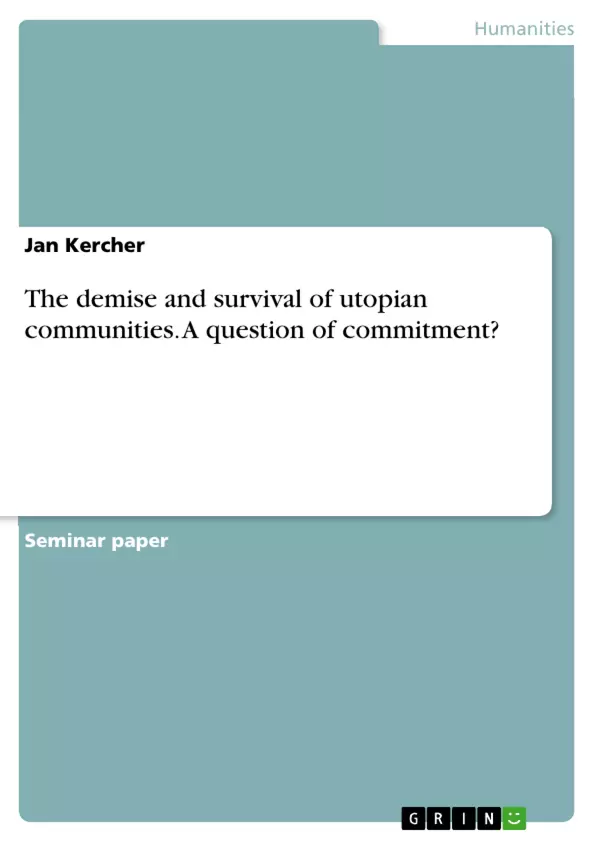“And me, I still believe in paradise. But now at least I know it’s not some place you can look for, cause it’s not where you go. It’s how you feel for a moment in your life when you’re a part of something, and if you find that moment... it lasts forever...” says Leonardo di Caprio at the end of the movie “The Beach”, upon return from a failed utopian island community. This statement, together with the whole movie, expresses a widespread conviction: utopian communities are bound to fail. “Paradise” is nothing that one can realize in an actual community. If anything, it can be realized as a feeling or a state of mind; but why do we think that way? Do we all feel that there is a sociological law that inevitably leads to the demise of a community that tries to realize the ideal society? Is this point of view empirically provable? These were the questions that intrigued me when I decided to make utopian communities my research topic; or, formulated into a single research question: Is there a single, most important feature or process that led to the demise or survival of former utopian communities?
To answer this question, we should first have a brief look at the great field of studies about the various kinds of utopias. This will help us achieve a better understanding and localization of the aspect of utopia we are looking at in this paper (utopian communities). At the same time, it will help us to find a useful definition of the vague and ambiguous term “utopia” and, more specifically, “utopian communities”. Subsequently, we will also have a brief look at the history of those communal experiments. After these prefatory remarks, I will introduce Rosabeth Moss Kanter’s concept of utopian commitment as a conceptual framework for the exploration of the longevity of utopian communities. Kanter’s functional concept is one of the few analytical models in this field. However, its functional approach is not unproblematic. Therefore a brief evaluation of its strengths and weaknesses seems necessary. Finally, I will use Kanter’s concept to analyse the developments of a failed utopian community (the Finnish colony of Sointula), which contrasts with a more successful community (the Shaker sect) and, thus, serves to test the concept’s validity.
Table of Contents
- Introduction and Research Question
- Exploring the field of subject
- Defining “Utopia”
- From Utopia to Communitarianism
- Communitarianism - A Recurrent Social Phenomenon?
- Demise or Survival? Introducing the theoretical framework
- Community and Commitment
- Problems and Limitations – Implications of Structural Functionalism?
- Applying the Theory - Commitment-Building in a Canadian commune
- Sointula
- A brief history
- Processes of community-building in Sointula
- Sointula
- Conclusion
Objectives and Key Themes
This research paper investigates the factors contributing to the demise or survival of utopian communities. The study seeks to determine if a single dominant feature or process underlies the success or failure of these communal experiments. This analysis aims to uncover the intricate relationship between community and commitment, particularly in the context of utopian aspirations.
- Defining "utopia" and its evolving forms
- The role of commitment in building and maintaining utopian communities
- Theoretical frameworks for understanding utopian community dynamics
- Case studies of utopian communities, examining their successes and failures
- Analyzing the interplay of social structures, individual commitment, and utopian ideals
Chapter Summaries
The paper starts by introducing the research question, which explores whether a common factor explains the demise or survival of utopian communities. It then delves into the vast field of utopian studies, analyzing various definitions of "utopia" and examining how the concept has evolved.
The paper then focuses on communitarianism, a specific form of utopianism emphasizing the creation of self-contained, close-knit communities. The theoretical framework of Rosabeth Moss Kanter's concept of utopian commitment is introduced to analyze the longevity of utopian communities.
The research uses the example of Sointula, a failed utopian community in Canada, to examine the application of Kanter's concept. This case study is compared to a more successful community to assess the validity of the theoretical framework.
Keywords
The research paper focuses on the keywords "utopia," "communitarianism," "commitment," "community," "social change," "structural functionalism," "case study," and "utopian communities."
- Citar trabajo
- Jan Kercher (Autor), 2004, The demise and survival of utopian communities. A question of commitment?, Múnich, GRIN Verlag, https://www.grin.com/document/26596



